|
 |
From the Archive
007 Issue #15 (1984) |
|
|
|
|
 |
|
Originally published
in 007 Issue #15 (1984) and
reprinted in 007 MAGAZINE 40th Anniversary Issue (September 2019). The
text of this interview is identical, but enhanced here with additional
images from the 007 MAGAZINE Archive. While visiting London in August 1982, to do research for my book,
The
James Bond Bedside Companion, I had the pleasurable opportunity to
meet and speak with Kingsley Amis. Mr. Amis, of course, is an extremely
well-known personality in England, and the author of several novels which
could be called “classic” (Lucky Jim (1954), Jake's Thing
(1978), among many others), as well as The James Bond Dossier
(1965) and COLONEL SUN (1968). I met him in a small flat in the North of
London. Workmen were adding something, or taking away something, to the
front of his building. Despite the racket, we managed to have a fun
conversation, mainly because we were simply two James Bond fans discussing
something for which we both had a fondness.
Did you know Ian Fleming?
I met him only a couple of times.
I guess that was late in his life?
Oh, yes; the first time was at a party. I said to him, “Mr Fleming, it is
very nice, it is very rare to meet an author to whom you can honestly say,
“I’ve read all your books and I enjoy them very much.” And he said,
“That’s very kind of you. Of course, you know they’re all true.” I said,
“Oh?” And he said, “Oh yes! If you go to that part of Moscow that I
describe in several of my works, particularly FROM RUSSIA, WITH LOVE, and
you go to that building on the Sretenka Ulitsa, you will find
Colonel General General Grubozaboyschikov, and all his friends – they’re
all there. Oh yes.” The other time was when I let him see the typescripts
of The James Bond Dossier before I sent it to the publishers, for
his comments. He kindly took me out to lunch – it was nice, quite
expensive – and if you’ll remember, there were quite a number of critical
comments I made on the style and that sort of thing – and he had nothing
to say on any of those. But he had points of accuracy he wanted to put me
right about. One was that it is the Royal and Ancient Golf Club, not the
St. Andrew’s. Another was that Oddjob was sucked out of the cabin
of the aircraft, not blown out. It was in that order. I think there
were only three. I got them wrong, he put me right. |
 |
|
ABOVE: (left) A 1986
George Almond
illustration commissioned by 007 MAGAZINE
depicting General Grubozaboyschikov as described in FROM RUSSIA,
WITH LOVE (1957) - Chapter Four ‘The Moguls of Death’. (right) A
1961 portrait of James Bond author Ian Fleming by celebrated
American photographer Dan Wynn (1920-1995).
BELOW: (left) The UK Jonathan Cape hardback edition of The James
Bond Dossier had a wraparound dust jacket designed by Jan
Pienkowski (1936-2022) based on the famous trompe l'oeil
paintings by Richard Chopping (1917-2008) reproduced on the dust
jackets of the Ian Fleming James Bond novels, whereas the US New
American Library hardcover edition (right) featured a simple
illustration by Paul Bacon (1923-2015) of Bond driving his beloved
Bentley. |
|
|
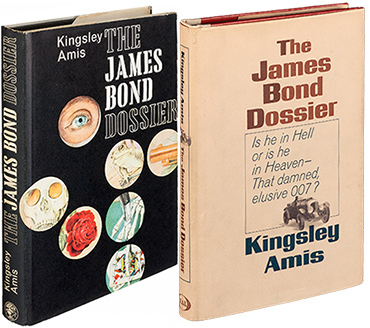 |
He seemed to
accept criticism very well.
Yes.
How did The
James Bond Dossier come about?
It’s in the preface to it, really. I was going to write an article. I
thought the books had been very seriously misrepresented in the papers
and so on, and I thought the record should be set straight. I wanted
people to pay attention to what he actually wrote, not on what
he didn’t write. I thought it would be a medium-sized magazine
article, but I found it became a small book.
Did you have to
get permission from Glidrose?
They approached me, afterwards, for the – are you talking about
COLONEL SUN? I didn’t have to get permission for the Dossier,
though I did inform them because it made life easier. I was able to
see the original reviews – always helpful to read the original
reviews. When it came to COLONEL SUN, they approached me. |
|
|
That was my next question!
Yes. And I started from scratch. One of the nicest compliments I’ve ever
had, I get it a lot, from strangers, mostly from the United States, who
write to me, usually male, and I would guess young (in their teens); after
saying nice things one said, “Can you confirm a rumour that you were shown
drafts and plans of Ian Fleming’s that he left behind him when he died
from which you based COLONEL SUN?” I wrote back and said, “Thank you very
much, you’ve paid me a high compliment because, no, not a word of his
survived. But you’re implying by saying that that you think COLONEL SUN is
a worthy continuation of what Fleming wrote.”
Why did you choose to
use a pseudonym?
Ah. Well, that was agreed between myself and the publisher and Glidrose.
Partly for my convenience. Because it set that apart from my other works.
But really, more at the time, it was considered possible that other
writers might like to have a crack at it. And so it would be there for all
other writers doing sequels in a few years – it would be less confusing if
they all had the same pseudonym. No attempt to persuade the public that it
was the same man, but it would be more convenient to market the books and
so on.
How was the book received at first?
Oh, very well. Very well by the public. The reviews, at any rate, were not
very friendly. But then, of course, Fleming’s reviews weren’t friendly
either. Also I got a lot of accusation, as Fleming did, that the writing
was fascist. “Oh, here’s another fascist.” |
|
|
|
I felt that COLONEL SUN dealt more with politics than most of
Fleming’s.
Did you?
Mainly because for the first time, Red China was in the picture…
Yes. Well that was actually for pure convenience. I certainly don’t
believe that the West will get together with the Russians and team up
against the Chinese. The Eastern Mediterranean. That was the place to go.
I had a good friend there who knew Greece; I had a standing invitation to
visit the place any time I liked. Well, this was the time I liked – it was
a place where Bond had never been, and I had an expert point things out to
me. Luckily, that’s very much one of Russia’s areas of interests. So it
worked out in plot purposes. The Chinese were close and convenient.
I particularly liked the female character. She seemed a bit more
well-drawn than Fleming’s women…
I thought it was important, I think he would have thought it was all
right. It was rather nice for her to ... do a little more.
COLONEL SUN was very nasty.
(Laughs) |
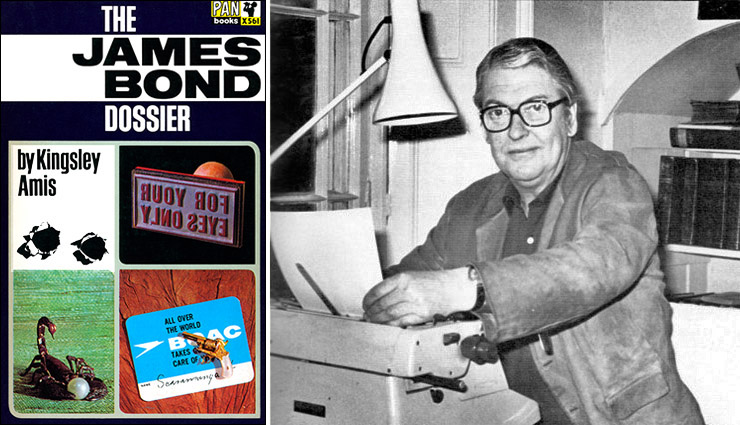 |
|
Is it true that Glidrose approached you again to do an update on The
James Bond Dossier?
It didn’t get quite as far as that. No, that’s not my recollection of it
at all. No, I’ve never thought of writing anything of any size again. It’s
been 15 years of time. I don’t think I’d change my mind on anything I’ve
said. All that’s happened since has been, a few articles and the like...
and the films. I suppose you will say something about all that.
Have you seen the John Gardner book?
Yes.
The second one is out in America. I feel it’s a little better than the
first one…
I thought the first one wasn’t good. And I think the second one ... is
even worse! I’m reading it now. I’m at the point where they’re about to
arrive at this fellow’s private…
…ranch?
Yes. And what has happened in between their point of arrival in New York
and this point is nonsense! Absolute nonsense. He arrives with this cover,
with the prints, and all that had to happen was for some very well-dressed
chap to say, “Oh, my principal would very much like you to accompany us to
Texas and show him your prints with no obligation. He would put you and
your lovely wife up as guests.” And they go and hide in that hotel,
disguising themselves, then taking the disguises off – it does no good –
and is SPECTRE trying to kill him, but at the same time not trying
to kill him? It’s hopelessly muddled. Isn’t it? |
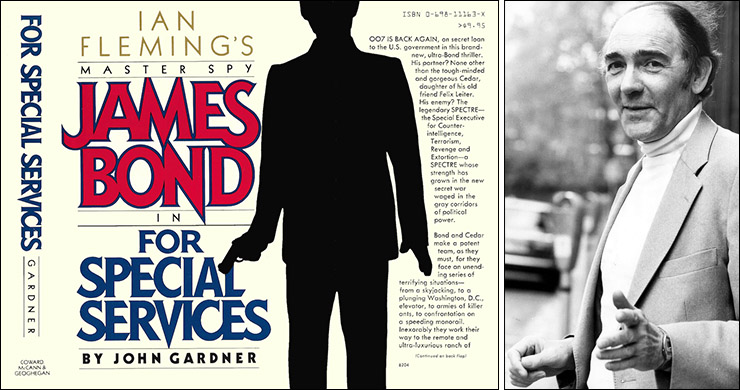 |
|
ABOVE: (left) The
dust jacket for the US edition of FOR SPECIAL SERVICES (1982)
published by Coward McCann & Geohegan. The dust jacket
illustrations for all John Gardner's original James Bond novels
first published in hardback in the USA were by Janet Tingey, with
the James Bond logo design by Lynn Hollyn Associates. (right)
British author John Gardner (1926-2007) was the most prolific
James Bond author after Ian Fleming, writing 13 original novels
and two novelizations based on the screenplays of Licence To
Kill (1989) and GoldenEye (1995). |
|
|
|
It works itself out. I felt the first one drew more on the films…
Yes. You know, it’s the motives – what exactly is SPECTRE trying to do? –
and all that business between New York and Texas – yes, it would go quite
well in a film. Because you’re not asking questions. “Oh, look, now
they’re in an elevator and the elevator’s crashing – what fun!” You don’t
worry about why or who’s doing it or what effect it’s going to have.
The films do that a lot…
The films do that a lot. And the girl…
Cedar?
No, in the armoury…
Oh! (Laughs) Q’ute!
(Grimaces.) That’s… terrible! The idea that Bond would have anything to do
with a liberated woman is… and the idea that he would ever take a woman on
as a partner is ridiculous!
And it’s his best friend’s daughter!
Of course! And the idea too that the President of the United States has so
little confidence in his own intelligence agents that he would overrule
them and say, “No, get someone from Great Britain – somebody who’s an
expert on SPECTRE!” |
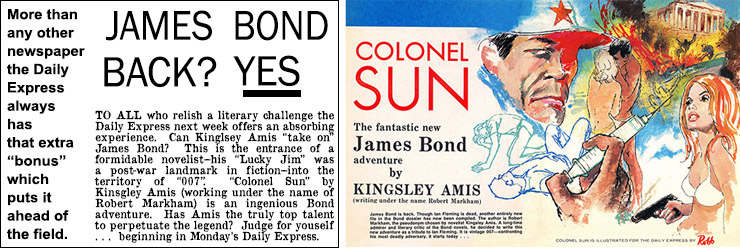 |
|
ABOVE: The Daily
Express serialized COLONEL SUN prior to its Jonathan Cape
hardback publication on March 28, 1968. The first instalment of
the 12-part adaptation of COLONEL SUN in the Daily Express on
March 18th had a superb introductory colour illustration by Andrew
Robb (1907-1989), which was very unusual for any newspaper at the
time. Robb had provided illustrations for most of the Daily
Express serializations of Ian Flemings novels and short
stories since 1956. COLONEL SUN would be the last James Bond novel
adapted by the newspaper. |
|
|
|
James Bond!
Or whatever that is! “And we’ll let him have the daughter of one of
our best CIA men.” Anyway, it’s interesting to me to… I only read OCTOPUSSY
once. I happened to find it on the shelf the other day, and I had
forgotten what happens in it. I read it again, and it’s definitely a
different literary world. The straightforward way that story is told…
every sentence is absolutely firm and clear. The Gardner book, by
contrast, is very hesitant and obscure.
Much of the detail seems to be put in for the sake of putting in
detail. You know what I mean?
Yes, I do know what you mean. That’s what I think myself. The
description of that house in the Everglades or wherever it is… it’s
hopeless! And you haven’t got what you have in the Fleming novels, in that
something happens from the beginning. For instance, when Bond goes
to Shrublands…
In THUNDERBALL?
Yes. You don’t see the point of that until you know… you know there
will be a point as soon as Bond discovers the meaning of that tattoo on
the SPECTRE fellow’s arm.
Your COLONEL SUN certainly started off with a bang!
Yes. Well, you see, it’s certainly not important to have a car chase on
page two, but there should be something right from the word go.
I felt COLONEL SUN might have been the most violent of the books…
Yes. And the torture scene – a lot of people objected to that. |
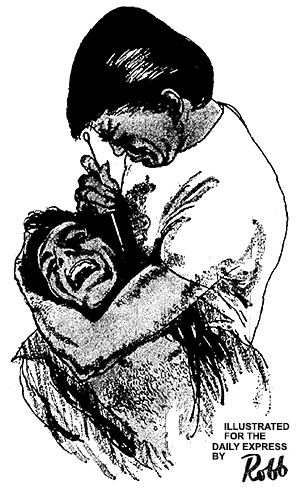 |
|
 |
|
COLONEL SUN was the
only James Bond story not written by Ian Fleming to be adapted
into a comic strip by the Daily Express. Published Monday
December 1, 1969 - Thursday August 30, 1970, COLONEL SUN was
adapted by James Lawrence (1918-1994) and illustrated by Yaroslav
Horak (1927-2020). Unusually the title strip does not credit
Kingsley Amis or ‘Jim’ Lawrence, and the title panel still
informed readers this was ‘Ian Fleming's James Bond’.
|
|
|
It was the worst one since CASINO ROYALE.
Yes.
Was that intentional?
Well, I thought if we’re going to have a torture scene it’s not going to
be like any other one we’ve had before. So, I got hold of my doctor – he
actually appears in the book – Dr. Allison – you remember when Bond’s
wandering around in the park and is taken to the police station? And the
police doctor who treats him? That was my doctor, Dr. Allison. Anyway, I
said to him, “Look, fix me up with a good torture.” He said, “Right! Good,
we’ll do it straight away.” I said, “Now forget all about his testicles,
we’ve done that, we’ve been through that. We’ve got to start somewhere
else.” And he said, “Well, it’s got to be inside the head.” He thought of
it in the space of 15 seconds. “That’s where you start, that’s what people
are really afraid of - what they can’t see.” This was proven correct.
I also liked the way you had the villain call him “James” rather than
the obligatory “Mister Bond.”
Oh yes! (Laughs) I forgot about that. You know, there’s one serious flaw
in COLONEL SUN that I didn’t know about until years later. And that is
that a mortar bomb would not explode when dropped on the ground.
Really?
I was totally surprised. Someone who had been an officer in our army said,
“That’s a very ingenious contraption developed in the war, but you know, a
mortar bomb, simply in its case, is harmless.” What are you going to do if
someone has a rough landing in an airplane? You can’t have the damn things
going off. They’re harmless. They’re armed in the nose and must hit their
target after they are fired. |
 |
|
ABOVE: Although
Colonel Sun's torture of James Bond in the 1970 comic strip was
toned down from the novel, much of the dialogue from the 1968
Kingsley Amis novel was retained. EON Productions acquired the
screen rights to COLONEL SUN shortly after publication but only
two sequences from the novel were used on screen. The kidnap of M
appeared in The World Is Not Enough (1999), and (below) the
torture sequence served as the basis for a similar scene between
James Bond (Daniel Craig) and Franz Oberhauser/Ernst Stavro
Blofeld (Christoph Waltz) in Spectre (2015), again
retaining some of the dialogue from novel. Accordingly, the estate
of Kingsley Amis was credited in the “Thanks to” acknowledgements
at the very end of the film. How many audience members actually
realised this is where the scene in the Daniel Craig's penultimate
appearance as 007 originated, or stayed until the very end of the
credits is debatable. |
|
 |
|
|
Well, I didn’t know.
Now you do. It really annoyed me.
You think a film will ever be made using the title?
The filmmakers have for some reason shown no interest in it.
What do you think of the films?
Well, the last one I saw was an incomplete print of The Spy Who Loved
Me. (Grimaces)
I get even more annoyed when I see that people actually think it’s funny!
They’ve gone too far into slapstick, to be sure…
Well, it affects the whole thing. I can’t think of the right film… early on
we have a parachute jump on skis, and the parachute opens up to be…
…a Union Jack.
(Loud exhale accompanied by a sour grimace.) …and the whole idea that he’s
up there, having no idea that there’s an enemy agent within a thousand
miles, and of course he’d carry a parachute! And the mothership in
whatever it is… the one with the submarines…
That’s The Spy Who Loved Me…
Is that the same one?
They’re all the same.
Yes. Well, that control room has bullet-proof blinds, but also holes
where you can point the guns through. “What are those holes for?” “Oh,
well that’s in case we take our people prisoner and they all
escape! We can shoot at them through these holes!!” |
 |
|
To coincide with its
hardback publication by Jonathan Cape, The James Bond Dossier
by Kingsley Amis was serialized in the Sunday Mirror over
four weeks beginning on May 9, 1965. Although the book was an
examination of the literary world of James Bond, a graphic
representation of Sean Connery formed part of the introductory
illustration. Sean Connery was so inextricably linked with the
role by 1965, it was his likeness that usually accompanied any
article or serialization of the James Bond novels or short stories
in numerous publications across the globe at the height of ‘Bondmania’...
much to the actor's chagrin. |
|
|
|
I guess you’ve heard the rumour that Sean Connery is doing a new film?
I’ve been wondering about the truth in all that.
Supposedly he’s going to do it at age 60, coerced out of retirement.
That reminds me of an idea for a short story I had that would round off
the whole saga. It was the kind of story you put in a Christmas annual.
This is the aged Commander Bond, age 70 probably, on holiday in
Switzerland. He doesn’t ski anymore. A very beautiful young girl, whose
father is a United States senator, comes up to him and says, “My father is
in danger. Sinister Colonel-General Monarvsky of the KGB has kidnapped
him. Please help me. You’re the only person I can ask. And I’ll do
anything if you help me.” So Bond says, “Well… it’s a bit late for
anything, I think… BUT… I’ll help you.” And of course, at the end, the
Russian general and Commander Bond are falling over a waterfall in each
other’s arms. When I told this to Glidrose, they all went white!
(In a slow, menacing whisper). “Don’t you dare print this! Not a word
of it!” I’m exaggerating, of course, but needless to say, they didn’t find
it in their favour at all… |
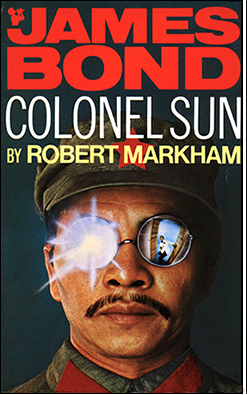 |
![1977 Panther Books paperback with a cover photograph by Beverley Goodway (1943-2012) [known as Beverly Le Barrow]](amis/cs_paperbacks_02.jpg) |
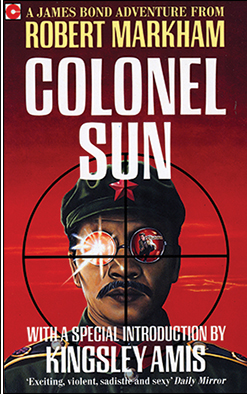 |
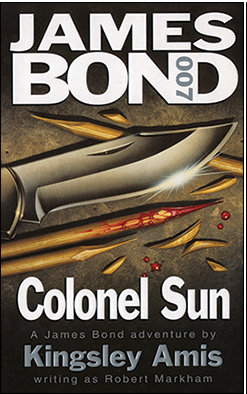 |
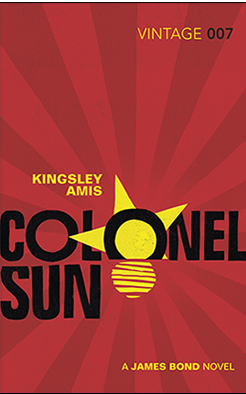 |
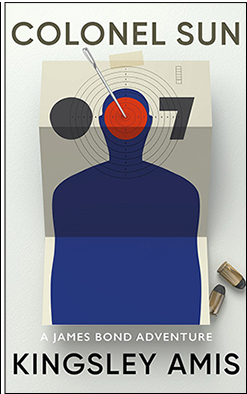 |
|
COLONEL SUN UK
paperbacks: (top right) 1970
PAN
Books first paperback edition featuring a photographic cover
with Jamaican-born actor Vincent Wong (1928-2015) portraying the
eponymous villain. (top centre) 1977
Panther
Books paperback with a cover photograph by Beverley Goodway
(1943-2012) [known as Beverly Le Barrow]. (top right) 1991
Coronet
Books edition featuring a painted version of the PAN Books
cover by artist Andy Walker. (bottom left) 1996 Coronet Books
re-issue with a cover painted by David Scutt. (bottom centre) 2015
Vintage
Books edition with a cover designed by Kris Potter. (bottom
right)
Ian Fleming Publications 2023 paperback edition of COLONEL SUN
with a cover designed by David Eldridge. |
|
|
|






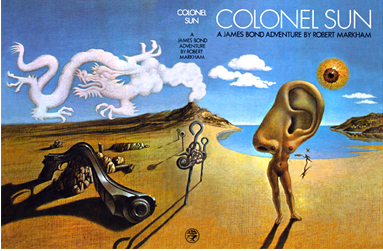
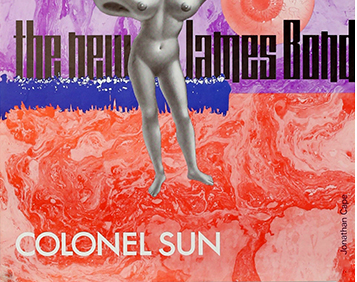
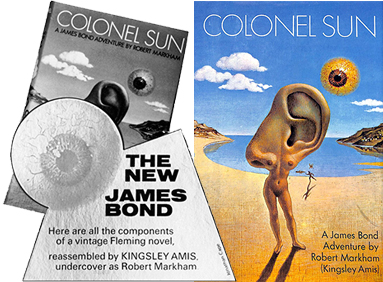
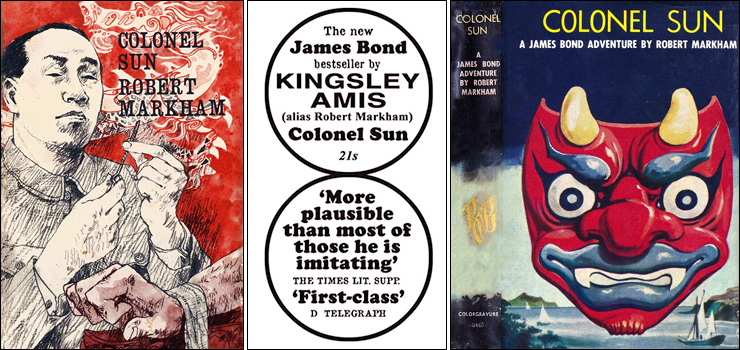








![1977 Panther Books paperback with a cover photograph by Beverley Goodway (1943-2012) [known as Beverly Le Barrow]](amis/cs_paperbacks_02.jpg)



